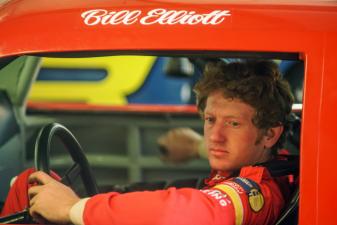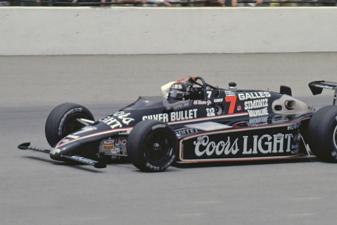Crashing to the Top

Journalists Al Pearce and Mike Hembree chronicle the journey of NASCAR’s best as they drive their way to that landmark first victory in 50 First Victories. With a combined ninety years of coverage of one of America’s grassroots sports, they bring a wealth of knowledge and experience to the stories of these fast-and-furious heroes, drivers who ran to the ragged edge—and often past it—in pursuit of the checkered flag. In this excerpt from the book, catch a sneak peek at Jimmie Johnson's path to victory.
Almost every successful racer recalls a special moment that helped kick-start his or her career. A chance meeting with an owner looking for a driver. Maybe winning a short feature race on a weekly track that caught the eye of a series official. Or perhaps an open audition among a handful of promising young prospects.
For seven-time NASCAR Cup Series champion Jimmie Johnson, that “special” moment was the twenty hours he was at the bottom of a ravine after crashing his Chevrolet truck during the 1995 SCORE Baja International 1,000 off-road race along the Mexican peninsula.
Before Johnson’s titles, his thirty-six poles, his eighty-three victories, and his almost inevitable selection to the NASCAR Hall of Fame, there was the Baja crash. It might seem a stretch, but Johnson credits that crash with helping him become the stock car driver he became.
It goes something like this:
In 1995, Johnson was nineteen and already making waves in stadium off-road and SCORE racing. Cocky to a fault, he had an attitude that even he later admitted was probably too much. That approach got him in trouble during the Tijuana-to-La Paz run down Mexico’s treacherous Baja Peninsula.
It was nearing dawn, and Johnson was hoping daylight would keep him awake. Instead, he dozed off and crashed his No. 82 Chevrolet truck in the mountains, flipping and tumbling to the bottom of a deep ravine. “I kept wondering how far we were going to fall and how hard we were going to land,” Johnson said several years ago. “I knew the possibility was there for a really bad situation. It’s a moment I hope to never go through again.”
Search teams needed twenty hours to find Johnson and his navigator, Tom Gieves, shaken but intact. Those hours might have been among the most important of Johnson’s career. “During the time in that ravine I did a lot of soul-searching about how I raced,” he said. “I learned a lot about myself out there. I was young and dumb and didn’t really care if I crashed. I made a lot of mistakes and crashed a bunch because I wasn’t afraid to stay on the gas all the time. I thought I needed that flash to get recognized.
“Maybe I fell into that [mindset] a little too much. I was crashing so much that my career was going in a bad direction. I was kind of known as a reckless driver, viewed as someone no owner would want in his equipment because the crew would have to always fix it.”
The Baja crash and subsequent offseason gave Johnson time to change his ways. He spent three more years in the dirt—and never got upside-down again. “In off-road terms, that’s a pretty big statement . . . three years without getting upside-down,” Johnson said. “That time out on the Baja thinking about what could have happened changed a lot in the way I went back racing.”







